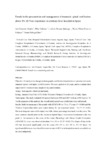Mostrar o rexistro simple do ítem
Trends in the presentation and management of traumatic spinal cord lesions above T6: 20-Year experience in a tertiary-level hospital in Spain
| dc.contributor.author | Esmorís, Inés | |
| dc.contributor.author | Galeiras, Rita | |
| dc.contributor.author | Seoane-Quiroga, L. | |
| dc.contributor.author | Ferreiro-Velasco, María Elena | |
| dc.contributor.author | Pértega-Díaz, Sonia | |
| dc.date.accessioned | 2022-06-30T10:31:42Z | |
| dc.date.available | 2022-06-30T10:31:42Z | |
| dc.date.issued | 2021-01-14 | |
| dc.identifier.citation | Arijón, I. E., Galeiras, R., Quiroga, L. S., Velasco, M., & Pértega Díaz, S. (2021). Trends in the presentation and management of traumatic spinal cord lesions above T6: 20-Year experience in a tertiary-level hospital in Spain. The journal of spinal cord medicine, 1–8. Advance online publication. https://doi.org/10.1080/10790268.2020.1851857 | es_ES |
| dc.identifier.issn | 1079-0268 | |
| dc.identifier.uri | http://hdl.handle.net/2183/31046 | |
| dc.description.abstract | [Abstract] Objective: To analyze the changes in demographic and lesion characteristics of persons with acute traumatic spinal cord injury (ATSCI) above T6 over a period of 20 years, and to evaluate their impact on ICU resources use, length of stay and mortality.Design: Retrospective observational study.Setting: Intensive Care Unit (ICU) of the University Hospital Complex of A Coruña, Spain.Participants: The study included 241 persons between 1998 and 2017 with an ATSCI above T6. For the purposes of the analysis, the overall study period was divided into three subperiods.Results: Both the mean age of the people with ATSCI (49 vs. 51 vs. 57 years; P = 0.046) and the Charlson Comorbidity Index were higher during the last subperiod (mean: 1.9 ± 2.2; P < 0.01). The most frequent cause of the injury was falls, whose percentage increased over the years. The most common classification in the American Spinal Injury Association Impairment scale was grade A. An increase in the score of the Acute Physiology and Chronic Health Evaluation (APACHE II) score was observed (median: 9 vs. 10 vs. 15; P < 0.01). The length of stay in the ICU has decreased significantly over the years (30 ± 19 vs. 22 ± 14 vs. 19 ± 13 days). No significant differences were found between the rates of ICU or in-hospital mortality recorded over the three subperiods.Conclusions: Despite the progressive increase in the age, comorbidity, and APACHE II, the length of ICU stay decreased significantly, with no associated changes in the mortality rates. | es_ES |
| dc.language.iso | eng | es_ES |
| dc.publisher | Taylor & Francis | es_ES |
| dc.relation.uri | https://doi.org/10.1080/10790268.2020.1851857 | es_ES |
| dc.rights | This is an Accepted Manuscript version of the following article, accepted for publication in The Journal of Spinal Cord Medicine. It is deposited under the terms of the Creative Commons Attribution-NonCommercial-NoDerivatives License (http://creativecommons.org/licenses/by-nc-nd/4.0/), which permits non-commercial re-use, distribution, and reproduction in any medium, provided the original work is properly cited, and is not altered, transformed, or built upon in any way. | es_ES |
| dc.subject | Acute spine trauma | es_ES |
| dc.subject | Epidemiology | es_ES |
| dc.subject | Mortality | es_ES |
| dc.subject | Spinal cord injury | es_ES |
| dc.title | Trends in the presentation and management of traumatic spinal cord lesions above T6: 20-Year experience in a tertiary-level hospital in Spain | es_ES |
| dc.type | info:eu-repo/semantics/article | es_ES |
| dc.rights.access | info:eu-repo/semantics/openAccess | es_ES |
| UDC.journalTitle | The Journal of Spinal Cord Medicine | es_ES |
Ficheiros no ítem
Este ítem aparece na(s) seguinte(s) colección(s)
-
INIBIC-ECB - Artigos [50]






